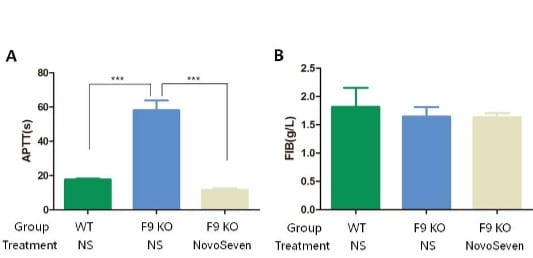Basic Information
Strain Name
C57BL/6-F9 tm1 /Bcgen
Stock Number
110170
Common Name
B-F9 KO mice
Source/Investigator
Bcgen (Beijing Biocytogen Co., Ltd)
Related Genes
F9;FIX(coagulation factor IX)
Background
C57BL/6
Appearance
Black
Genotypes
Heterozygote
Development
The B-F9 KO mice were developed by Beijing Biocytogen Co., Ltd. The Exons 1-3 of mice were knocked out.
NCBI Gene ID
-
Targeting Strategy

-

-
Details

-
Genotyping Information
Primer Sequence (5’-3’) Tm
(℃)Product size
(bp)F9-Mut-F3 GGTACTGTGTACTGTTCCCAATTACAG
A63 WT: 7049
Mut: 563F9-Mut-R2 GAATTGGACCTCAGGTAGATGGAGC 63 F9-WT-F3 AACACGTTGCAGAAAGATCCTGTCA 63 WT: 474 F9-WT-R3 AAGTCAGCCTGTGAAATGTCCCTCA 64 Polymerase: Taq
Application
NovoSeven efficacy evaluation

Animals were randomly divided into Control group or NovoSeven (1 mg/kg), After 30 minutes treatment, the abdominal aorta was collected blood for ATPP (activated partial thromboplastin time) and FIB (Fibrinogen) detection. The results showed that the APTT recovered to normal after drug treatment compared with the control group. FIB values were not significantly different from WT mice. A:ATPP±SEM; B: FIB±SEM.
-
References

-
1. Blood. 1998 Jul 1;92(1):168-74
2. Proc Natl Acad Sci U S A. 1997 Oct 14;94(21):11563-6.


